Demographics of Spain
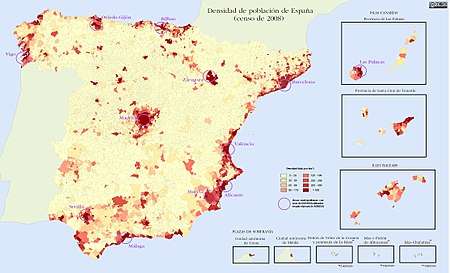
| Historical population | ||
|---|---|---|
| Year | Pop. | ±% |
| 1833 | 12,286,941 | — |
| 1846 | 12,162,872 | −1.0% |
| 1857 | 15,464,340 | +27.1% |
| 1877 | 16,622,175 | +7.5% |
| 1887 | 17,549,608 | +5.6% |
| 1900 | 18,616,630 | +6.1% |
| 1910 | 19,990,669 | +7.4% |
| 1920 | 21,388,551 | +7.0% |
| 1930 | 23,677,095 | +10.7% |
| 1940 | 26,014,278 | +9.9% |
| 1950 | 28,117,873 | +8.1% |
| 1960 | 30,582,936 | +8.8% |
| 1970 | 33,956,047 | +11.0% |
| 1981 | 37,683,363 | +11.0% |
| 1991 | 38,872,268 | +3.2% |
| 2001 | 40,847,371 | +5.1% |
| 2011 | 46,815,916 | +14.6% |
| 2017 | 46,528,966 | −0.6% |
| Source: INE | ||
As of 1 January 2014, Spain had a total population of 46,507,760, which represents a 0.5% decrease since 2013.[1] The CIA Factbook (2011) gives a racial description of "composite of Mediterranean and Nordic types" under "ethnic groups" instead of the usual breakdown of ethnic composition. This reflects the formation of the modern Kingdom of Spain by the accretion of several independent Iberian realms, like León, Castile, Navarre, the Crown of Aragon, and Granada, among others.
Spain's population peaked in 2012, at 46,818,216 people. Spain's official population fell by 206,000 to 47.1 million, mostly because of immigrants returning home due to the effects of the European economic and fiscal crisis.[2] Its population density, at 91.4 inhabitants per square kilometre (237/sq mi), is lower than that of most Western European countries. With the exception of the capital Madrid, the most densely populated areas lie around the coast.
The population of Spain doubled during the twentieth century, but the pattern of growth was extremely uneven due to large-scale internal migration from the rural interior to the industrial cities, a phenomenon which happened later than in other Western European countries. No fewer than eleven of Spain's fifty provinces saw an absolute decline in population over the century.
The last quarter of the century saw a dramatic fall in birth rates. Spain's fertility rate of 1.47 (the number of children the average woman will have during her lifetime) is lower than the EU average, but has climbed every year since the late 1990s. The birth rate has climbed in 10 years from 9.10 births per 1000 people per year in 1996 to 10.9 in 2006.
Spain has no official religion. The Spanish Constitution of 1978 abolished the Roman Catholic Church as the official state religion, while recognizing the role it plays in Spanish society. As of 2018, 68.5% of the population define themselves as Catholic, 26.4% as non-believers or atheists, and 2.6% other religions. [3] Among believers, 59% assert they almost never go to any religious service, by contrast, 16.3% attend one or more religious service almost every week. [3] Practical secularization is strong[4][5] and most, especially those of the younger generations, ignore the religious doctrines on issues such as pre-marital sex, sexual orientation or contraception.[6][7]
Immigration and Demographic Issues
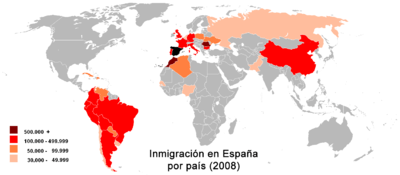
The population of Spain doubled during the twentieth century as a result of the spectacular demographic boom in the 1960s and early 1970s. After that time, the birth rate plunged through the 1980s and Spain's population became stalled, its demographics showing one of the lowest sub replacement fertility rates in the world, only above Greece, Portugal, Hungary, Ukraine, and Japan.
Many demographers have linked Spain's very low fertility rate to the country's lack of any real family planning policy. Spain spends the least on family support out of all western European countries—0.5% of GDP. A graphic illustration of the enormous social gulf in this field is the fact that a Spanish family would need to have 57 children to enjoy the same financial support as a family with 3 children in Luxembourg.
In terms of emigration vs. immigration, after centuries of net emigration, Spain, has recently experienced large-scale immigration for the first time in modern history. According to the Spanish government there were 5,730,667 foreign residents in Spain as of January 2011. Of these, more than 860,000 were Romanian, and half 760,000 were Moroccan while the number of Ecuadorians was around 390,000. Colombian population amounted to around 300,000. There are also a significant number of British (359,076 as of 2011, but more than one million are estimated to live permanently in Spain) and German (195,842) citizens, mainly in Alicante, Málaga provinces, Balearic Islands and Canary Islands. Chinese number over 166,000. Immigrants from several sub-Saharan African countries have also settled in Spain as contract workers, although they represent only 4.08% of all the foreign residents in the country.
During the early 2000s, the mean year-on-year demographic growth set a new record with its 2003 peak variation of 2.1%, doubling the previous record reached back in the 1960s when a mean year-on-year growth of 1% was experienced.[8] In 2005 alone, the immigrant population of Spain increased by 700,000 people.[9].
The arrival of migrating young adults was the main reason for the slight increase in Spain's fertility rate.[10] From 2002 through 2008 the Spanish population grew by 8%, of which 7% were foreign.[11]
Vital statistics
Notable events in modern Spanish demography:
- Late 19th century and early 20th century: Relative economic stagnation and mass emigration to American countries.
- 1918. Flu pandemic, over 200,000 dead in Spain.
- 1936. Start of the Spanish Civil War.
- 1939. End of the Civil War. Establishment of a national-catholic dictatorship, contraception and abortion were banned. Start of rationing policies. Deepening of economic depression, mass emigration to European and American countries due to economic and political motives (Republican exile).
- 1941. Approval of benefits for large families, with at least four children.[12]
- 1945. Establishment of tax deductions for parents.[13]
- 1952. End of rationing policies.
- 1975. End of the dictatorship, mass return of emigrated people.
- 1977. Legalization of contraception. Decline of birth rates.
- 1985. Legalization of abortion.
- 1988. As Spain became a developed country, the first events of illegal immigration from Africa occur.[14]
- 1991. Spain becomes a net receiver of immigrants, after decades of mass emigration.[15]
- 1994. Lowering of threshold of requirements to become a large family, only three children needed.[12]
- 2007. Approval of €2,500 benefit for births.
- 2010. Legalization of abortion on demand.
- 2011. Withdrawal of the €2,500 benefit for births.
- 2015. First negative natural change since the Civil War due to the aging of Spanish population.
Life expectancy from 1882 to 2015
Sources: Our World In Data and the United Nations.
1882-1950
| Years | 1882 | 1892 | 1900 | 1908 | 1909 | 1910 | 1911 | 1912 | 1913 | 1914 | 1915 | 1916 | 1917 | 1918 | 1919 | 1920[16] |
|---|---|---|---|---|---|---|---|---|---|---|---|---|---|---|---|---|
| Life expectancy in Spain | 29.5 | 32.1 | 34.8 | 41.3 | 41.0 | 40.8 | 39.7 | 43.4 | 42.5 | 42.8 | 43.0 | 42.9 | 42.5 | 30.3 | 41.1 | 39.2 |
| Years | 1921 | 1922 | 1923 | 1924 | 1925 | 1926 | 1927 | 1928 | 1929 | 1930[16] |
|---|---|---|---|---|---|---|---|---|---|---|
| Life expectancy in Spain | 42.0 | 44.1 | 44.7 | 46.2 | 46.9 | 47.7 | 48.4 | 48.6 | 49.3 | 49.3 |
| Years | 1931 | 1932 | 1933 | 1934 | 1935 | 1936 | 1937 | 1938 | 1939 | 1940[16] |
|---|---|---|---|---|---|---|---|---|---|---|
| Life expectancy in Spain | 49.2 | 51.1 | 51.5 | 52.3 | 52.6 | 51.0 | 47.3 | 47.6 | 47.2 | 48.4 |
| Years | 1941 | 1942 | 1943 | 1944 | 1945 | 1946 | 1947 | 1948 | 1949 | 1950[16] |
|---|---|---|---|---|---|---|---|---|---|---|
| Life expectancy in Spain | 47.2 | 52.5 | 54.8 | 56.2 | 57.8 | 57.5 | 59.3 | 61.2 | 61.0 | 61.8 |
1950-2015
| Period | Life expectancy in Years |
Period | Life expectancy in Years |
|---|---|---|---|
| 1950–1955 | 64.6 | 1985–1990 | 76.9 |
| 1955–1960 | 67.8 | 1990–1995 | 77.6 |
| 1960–1965 | 69.9 | 1995–2000 | 78.8 |
| 1965–1970 | 71.4 | 2000–2005 | 79.9 |
| 1970–1975 | 72.7 | 2005–2010 | 81.2 |
| 1975–1980 | 74.4 | 2010–2015 | 82.5 |
| 1980–1985 | 76.1 |
Source: UN World Population Prospects[17]
Total Fertility Rate from 1850 to 1899
The total fertility rate is the number of children born per woman. It is based on fairly good data for the entire period. Sources: Our World In Data and Gapminder Foundation.[18]
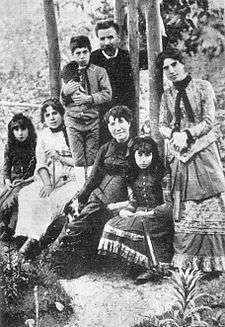
| Years | 1850 | 1851 | 1852 | 1853 | 1854 | 1855 | 1856 | 1857 | 1858 | 1859 | 1860[18] |
|---|---|---|---|---|---|---|---|---|---|---|---|
| Total Fertility Rate in Spain | 5.13 | 5.07 | 5.01 | 4.95 | 4.89 | 4.83 | 4.78 | 4.72 | 4.66 | 4.75 | 4.86 |
| Years | 1861 | 1862 | 1863 | 1864 | 1865 | 1866 | 1867 | 1868 | 1869 | 1870[18] |
|---|---|---|---|---|---|---|---|---|---|---|
| Total Fertility Rate in Spain | 5.16 | 5.09 | 5 | 5.19 | 5.11 | 5.07 | 5.09 | 4.72 | 4.9 | 4.84 |
| Years | 1871 | 1872 | 1873 | 1874 | 1875 | 1876 | 1877 | 1878 | 1879 | 1880[18] |
|---|---|---|---|---|---|---|---|---|---|---|
| Total Fertility Rate in Spain | 4.83 | 4.83 | 4.82 | 4.81 | 4.8 | 4.79 | 4.78 | 4.78 | 4.74 | 4.7 |
| Years | 1881 | 1882 | 1883 | 1884 | 1885 | 1886 | 1887 | 1888 | 1889 | 1890[18] |
|---|---|---|---|---|---|---|---|---|---|---|
| Total Fertility Rate in Spain | 4.91 | 4.79 | 4.71 | 4.86 | 4.8 | 4.86 | 4.78 | 4.82 | 4.82 | 4.55 |
| Years | 1891 | 1892 | 1893 | 1894 | 1895 | 1896 | 1897 | 1898 | 1899[18] |
|---|---|---|---|---|---|---|---|---|---|
| Total Fertility Rate in Spain | 4.67 | 4.71 | 4.71 | 4.6 | 4.63 | 4.75 | 4.51 | 4.41 | 4.53 |
Statistics since 1900

|
1.5 - 1.7
1.4 - 1.5
1.3 - 1.4
< 1.3 |
| [19][20][18] | Average population | Live births | Deaths | Natural change | Crude birth rate (per 1000) | Crude death rate (per 1000) | Natural change (per 1000) | Total fertility rates[fn 1][18] |
|---|---|---|---|---|---|---|---|---|
| 1900 | 18 520 000 | 627 848 | 536 716 | 91 132 | 33.9 | 29.0 | 4.9 | 4.49 |
| 1901 | 18 610 000 | 650 649 | 517 575 | 133 074 | 35.0 | 27.8 | 7.1 | 4.71 |
| 1902 | 18 720 000 | 666 687 | 488 289 | 178 398 | 35.6 | 26.1 | 9.6 | 4.7 |
| 1903 | 18 810 000 | 685 265 | 470 387 | 214 878 | 36.4 | 25.0 | 11.4 | 4.68 |
| 1904 | 18 980 000 | 649 878 | 486 889 | 162 989 | 34.2 | 25.7 | 8.6 | 4.67 |
| 1905 | 19 110 000 | 670 651 | 491 369 | 179 282 | 35.1 | 25.7 | 9.4 | 4.66 |
| 1906 | 19 250 000 | 650 385 | 499 018 | 151 367 | 33.8 | 25.9 | 7.8 | 4.61 |
| 1907 | 19 380 000 | 646 371 | 472 007 | 174 364 | 33.3 | 24.4 | 9.0 | 4.57 |
| 1908 | 19 530 000 | 658 008 | 460 946 | 197 062 | 33.7 | 23.6 | 10.1 | 4.52 |
| 1909 | 19 670 000 | 650 498 | 466 648 | 183 850 | 33.1 | 23.7 | 9.3 | 4.48 |
| 1910 | 19 770 000 | 646 975 | 456 158 | 190 817 | 32.7 | 23.1 | 9.7 | 4.43 |
| 1911 | 19 950 000 | 628 443 | 466 525 | 161 918 | 31.5 | 23.4 | 8.1 | 4.39 |
| 1912 | 20 040 000 | 637 860 | 426 297 | 211 563 | 31.8 | 21.3 | 10.6 | 4.35 |
| 1913 | 20 170 000 | 617 850 | 449 349 | 168 501 | 30.6 | 22.3 | 8.4 | 4.3 |
| 1914 | 20 310 000 | 608 207 | 450 340 | 157 867 | 29.9 | 22.2 | 7.8 | 4.26 |
| 1915 | 20 430 000 | 631 462 | 452 479 | 178 983 | 30.9 | 22.1 | 8.8 | 4.22 |
| 1916 | 20 610 000 | 599 011 | 441 673 | 157 338 | 29.1 | 21.4 | 7.6 | 4.2 |
| 1917 | 20 740 000 | 602 139 | 465 722 | 136 417 | 29.0 | 22.5 | 6.6 | 4.19 |
| 1918 | 20 910 000 | 612 637 | 695 758 | -83 121 | 29.3 | 33.3 | -4.0 | 4.17 |
| 1919 | 21 000 000 | 585 963 | 482 752 | 103 211 | 27.9 | 23.0 | 4.9 | 4.16 |
| 1920 | 21 130 000 | 623 339 | 494 540 | 128 799 | 29.5 | 23.4 | 6.1 | 4.14 |
| 1921 | 21 270 000 | 648 892 | 455 469 | 193 423 | 30.5 | 21.4 | 9.1 | 4.08 |
| 1922 | 21 510 000 | 656 093 | 441 330 | 214 763 | 30.5 | 20.5 | 10.0 | 4.02 |
| 1923 | 21 740 000 | 662 576 | 449 683 | 212 893 | 30.5 | 20.7 | 9.8 | 4.02 |
| 1924 | 21 990 000 | 653 085 | 430 590 | 222 495 | 29.7 | 19.6 | 10.1 | 3.92 |
| 1925 | 22 160 000 | 644 741 | 432 400 | 212 341 | 29.1 | 19.5 | 9.6 | 3.82 |
| 1926 | 22 400 000 | 663 401 | 420 838 | 242 563 | 29.6 | 18.8 | 10.8 | 3.87 |
| 1927 | 22 610 000 | 636 028 | 419 816 | 216 212 | 28.1 | 18.6 | 9.6 | 3.7 |
| 1928 | 22 860 000 | 666 240 | 413 002 | 253 238 | 29.1 | 18.1 | 11.1 | 3.8 |
| 1929 | 23 120 000 | 653 668 | 407 486 | 246 182 | 28.3 | 17.6 | 10.7 | 3.69 |
| 1930 | 23 340 000 | 660 860 | 394 488 | 266 372 | 28.3 | 16.9 | 11.4 | 3.68 |
| 1931 | 23 510 000 | 649 276 | 408 977 | 240 299 | 27.6 | 17.4 | 10.2 | 3.58 |
| 1932 | 23 897 000 | 670 670 | 388 900 | 281 770 | 28.3 | 16.5 | 11.8 | 3.64 |
| 1933 | 24 122 000 | 667 866 | 394 750 | 273 116 | 27.9 | 16.5 | 11.4 | 3.59 |
| 1934 | 24 349 000 | 641 889 | 392 793 | 249 096 | 26.4 | 16.1 | 10.2 | 3.38 |
| 1935 | 24 578 000 | 636 725 | 388 757 | 247 968 | 25.9 | 15.8 | 10.1 | 3.31 |
| 1936 | 24 810 000 | 617 220 | 417 108 | 200 112 | 24.9 | 16.8 | 8.1 | 3.18 |
| 1937 | 25 043 000 | 568 977 | 475 310 | 93 667 | 22.7 | 19.0 | 3.7 | 2.89 |
| 1938 | 25 279 000 | 508 726 | 487 546 | 21 180 | 20.1 | 19.3 | 0.8 | 2.56 |
| 1939 | 25 517 000 | 422 345 | 472 611 | -50 266 | 16.6 | 18.5 | -2.0 | 2.12 |
| 1940 | 25 757 000 | 631 285 | 428 416 | 202 869 | 24.5 | 16.6 | 7.9 | 3.09 |
| 1941 | 25 999 000 | 511 157 | 487 748 | 23 409 | 19.7 | 18.8 | 0.9 | 2.47 |
| 1942 | 26 244 000 | 530 845 | 387 844 | 143 001 | 20.2 | 14.8 | 5.4 | 2.53 |
| 1943 | 26 491 000 | 606 971 | 352 587 | 254 384 | 22.9 | 13.3 | 9.6 | 2.88 |
| 1944 | 26 620 000 | 602 091 | 349 114 | 253 796 | 22.6 | 13.1 | 9.5 | 2.84 |
| 1945 | 26 770 000 | 621 558 | 330 581 | 290 977 | 23.2 | 12.3 | 10.9 | 2.91 |
| 1946 | 27 030 000 | 585 381 | 353 371 | 232 010 | 21.7 | 13.1 | 8.6 | 2.7 |
| 1947 | 27 150 000 | 588 732 | 330 341 | 258 391 | 21.7 | 12.2 | 9.5 | 2.67 |
| 1948 | 27 593 000 | 642 041 | 305 310 | 336 731 | 23.3 | 11.1 | 12.2 | 2.88 |
| 1949 | 27 811 000 | 601 759 | 321 541 | 280 218 | 21.6 | 11.6 | 10.1 | 2.68 |
| 1950 | 28 009 000 | 565 378 | 305 934 | 259 444 | 20.2 | 10.9 | 9.3 | 2.45 |
| 1951 | 28 236 000 | 567 474 | 327 236 | 240 238 | 20.1 | 11.6 | 8.5 | 2.47 |
| 1952 | 28 474 000 | 593 019 | 276 735 | 316 284 | 20.8 | 9.7 | 11.1 | 2.51 |
| 1953 | 28 713 000 | 589 188 | 278 522 | 310 666 | 20.5 | 9.7 | 10.8 | 2.55 |
| 1954 | 28 955 000 | 577 886 | 264 668 | 313 218 | 20.0 | 9.1 | 10.8 | 2.59 |
| 1955 | 29 199 000 | 598 970 | 274 188 | 324 782 | 20.5 | 9.4 | 11.1 | 2.62 |
| 1956 | 29 445 000 | 608 121 | 290 410 | 317 711 | 20.7 | 9.9 | 10.8 | 2.66 |
| 1957 | 29 693 000 | 646 784 | 293 502 | 353 282 | 21.8 | 9.9 | 11.9 | 2.69 |
| 1958 | 29 943 000 | 653 216 | 260 683 | 392 533 | 21.8 | 8.7 | 13.1 | 2.72 |
| 1959 | 30 195 000 | 654 474 | 269 591 | 384 883 | 21.7 | 8.9 | 12.7 | 2.74 |
| 1960 | 30 455 000 | 663 375 | 268 941 | 394 434 | 21.8 | 8.8 | 13.0 | 2.77 |
| 1961 | 30 744 000 | 654 616 | 263 441 | 391 175 | 21.3 | 8.6 | 12.7 | 2.79 |
| 1962 | 31 067 000 | 658 816 | 278 575 | 380 241 | 21.2 | 9.0 | 12.2 | 2.8 |
| 1963 | 31 393 000 | 671 520 | 282 460 | 389 060 | 21.4 | 9.0 | 12.4 | 2.82 |
| 1964 | 31 723 000 | 697 697 | 273 955 | 423 742 | 22.0 | 8.6 | 13.4 | 2.83 |
| 1965 | 32 056 000 | 676 361 | 274 271 | 402 090 | 21.1 | 8.6 | 12.5 | 2.83 |
| 1966 | 32 394 000 | 669 919 | 276 173 | 393 746 | 20.7 | 8.5 | 12.2 | 2.84 |
| 1967 | 32 734 000 | 680 125 | 280 494 | 399 631 | 20.8 | 8.6 | 12.2 | 2.85 |
| 1968 | 33 079 000 | 667 311 | 282 628 | 384 683 | 20.2 | 8.5 | 11.6 | 2.86 |
| 1969 | 33 427 000 | 666 568 | 303 402 | 363 166 | 19.9 | 9.1 | 10.9 | 2.87 |
| 1970 | 33 779 000 | 663 667 | 286 067 | 377 600 | 19.6 | 8.5 | 11.2 | 2.88 |
| 1971 | 34 216 000 | 672 092 | 308 516 | 363 576 | 19.7 | 9.0 | 10.6 | 2.88 |
| 1972 | 34 572 000 | 672 405 | 285 508 | 386 897 | 19.5 | 8.3 | 11.2 | 2.86 |
| 1973 | 34 921 000 | 672 963 | 301 803 | 371 160 | 19.3 | 8.7 | 10.7 | 2.84 |
| 1974 | 35 288 000 | 688 711 | 300 403 | 388 308 | 19.6 | 8.5 | 11.0 | 2.89 |
| 1975 | 35 688 000 | 669 378 | 298 192 | 371 186 | 18.8 | 8.4 | 10.5 | 2.75 |
| 1976 | 36 118 000 | 677 456 | 299 007 | 378 449 | 18.9 | 8.3 | 10.5 | 2.68 |
| 1977 | 36 564 000 | 656 357 | 294 324 | 362 033 | 18.1 | 8.1 | 10.0 | 2.59 |
| 1978 | 36 741 000 | 636 892 | 296 781 | 340 111 | 17.3 | 8.1 | 9.2 | 2.48 |
| 1979 | 37 289 000 | 601 992 | 291 213 | 310 779 | 16.2 | 7.8 | 8.4 | 2.36 |
| 1980 | 37 527 000 | 571 018 | 289 344 | 281 674 | 15.2 | 7.7 | 7.5 | 2.22 |
| 1981 | 37 741 000 | 533 008 | 293 386 | 239 622 | 14.1 | 7.8 | 6.3 | 2.09 |
| 1982 | 37 942 000 | 515 706 | 286 655 | 229 051 | 13.6 | 7.6 | 6.0 | 1.96 |
| 1983 | 38 122 000 | 485 352 | 302 569 | 182 783 | 12.7 | 7.9 | 4.8 | 1.84 |
| 1984 | 38 279 000 | 473 281 | 299 409 | 173 872 | 12.4 | 7.8 | 4.5 | 1.73 |
| 1985 | 38 419 000 | 456 298 | 312 532 | 143 766 | 11.9 | 8.1 | 3.7 | 1.64 |
| 1986 | 38 536 000 | 438 750 | 310 413 | 128 337 | 11.4 | 8.1 | 3.3 | 1.56 |
| 1987 | 38 631 000 | 426 782 | 310 073 | 116 709 | 11.0 | 8.0 | 3.0 | 1.50 |
| 1988 | 38 716 000 | 418 919 | 319 437 | 99 482 | 10.8 | 8.3 | 2.6 | 1.45 |
| 1989 | 38 792 000 | 408 434 | 324 796 | 83 638 | 10.5 | 8.4 | 2.2 | 1.40 |
| 1990 | 38 851 000 | 401 425 | 333 142 | 68 283 | 10.3 | 8.6 | 1.8 | 1.36 |
| 1991 | 38 940 000 | 395 989 | 337 691 | 58 298 | 10.2 | 8.7 | 1.5 | 1.33 |
| 1992 | 39 068 000 | 396 747 | 331 515 | 65 232 | 10.2 | 8.5 | 1.7 | 1.32 |
| 1993 | 39 190 000 | 385 786 | 339 661 | 46 125 | 9.8 | 8.7 | 1.2 | 1.26 |
| 1994 | 39 295 000 | 370 148 | 338 242 | 31 906 | 9.4 | 8.6 | 0.8 | 1.21 |
| 1995 | 39 387 000 | 363 469 | 346 227 | 17 242 | 9.2 | 8.8 | 0.4 | 1.18 |
| 1996 | 39 478 000 | 362 626 | 351 449 | 11 177 | 9.2 | 8.9 | 0.3 | 1.17 |
| 1997 | 39 582 000 | 369 035 | 349 521 | 19 514 | 9.3 | 8.8 | 0.5 | 1.19 |
| 1998 | 39 721 000 | 365 193 | 360 511 | 4 682 | 9.2 | 9.1 | 0.1 | 1.15 |
| 1999 | 39 927 000 | 380 130 | 371 102 | 9 028 | 9.5 | 9.3 | 0.2 | 1.20 |
| 2000 | 40 264 000 | 397 632 | 360 391 | 37 241 | 9.9 | 9.0 | 0.9 | 1.23 |
| 2001 | 40 476 000 | 406 380 | 360 131 | 46 249 | 10.0 | 8.8 | 1.1 | 1.24 |
| 2002 | 41 035 000 | 418 846 | 368 618 | 50 228 | 10.1 | 8.9 | 1.2 | 1.26 |
| 2003 | 41 827 000 | 441 881 | 384 828 | 57 053 | 10.5 | 9.2 | 1.4 | 1.31 |
| 2004 | 42 547 000 | 454 591 | 371 934 | 82 657 | 10.6 | 8.7 | 1.9 | 1.33 |
| 2005 | 43 296 000 | 466 371 | 387 355 | 79 016 | 10.7 | 8.9 | 1.8 | 1.35 |
| 2006 | 44 009 000 | 482 957 | 371 478 | 111 479 | 10.9 | 8.4 | 2.5 | 1.36 |
| 2007 | 44 784 000 | 492 527 | 385 361 | 107 166 | 10.9 | 8.5 | 2.4 | 1.40 |
| 2008 | 45 668 000 | 519 779 | 386 324 | 133 455 | 11.4 | 8.4 | 3.0 | 1.46 |
| 2009 | 46 239 000 | 494 997 | 384 933 | 110 064 | 10.7 | 8.3 | 2.4 | 1.39 |
| 2010 | 46 486 000 | 486 575 | 382 047 | 104 528 | 10.5 | 8.2 | 2.3 | 1.38 |
| 2011 | 46 667 000 | 471 999 | 387 911 | 84 536 | 10.2 | 8.3 | 1.9 | 1.34 |
| 2012 | 46 818 000 | 454 648 | 402 950 | 51 698 | 9.7 | 8.6 | 1.1 | 1.32 |
| 2013 | 46 728 000 | 425 715 | 390 419 | 35 296 | 9.1 | 8.3 | 0.8 | 1.27 |
| 2014 | 46 508 000 | 427 595 | 395 830 | 31 765 | 9.1 | 8.5 | 0.6 | 1.32 |
| 2015 | 46 449 000 | 420 290 | 422 568 | -2 278 | 9.0 | 9.1 | -0.1 | 1.33 |
| 2016 | 46 440 000 | 410 583 | 410 611 | -28 | 8.8 | 8.8 | -0.0 | 1.34 |
| 2017 | 46 549 000 | 391 930 | 423 643 | -31 245 | 8.4 | 9.1 | -0.7 | 1.31 |
Current vital statistics[21]
- Births January–June 2016 =

- Births January–June 2017 =

- Deaths January–June 2016 =

- Deaths January–June 2017 =

- Natural increase January–June 2016 =

- Natural increase January–June 2017 =

Other demographic statistics
The following demographic statistics are from the World Population Review.[22]
- One birth every 1 minutes
- One death every 1 minutes
- Net gain of one person every 42 minutes
- One net migrant every 13 minutes
The following demographic statistics are from the CIA World Factbook, unless otherwise indicated.[23]
- Population
48,958,159 (2017 est.) 46,529,002 (July 2010 est.)
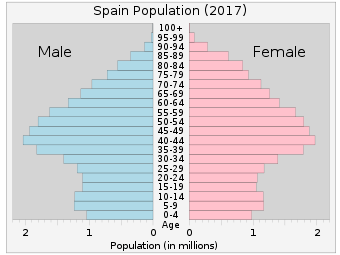
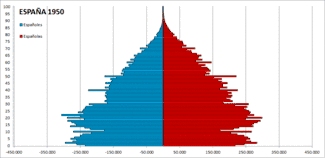

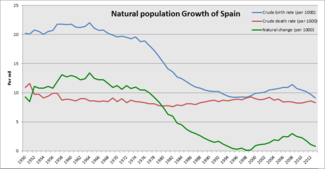
- Age structure
0-14 years:
15.3% (male 3,872,763/female 3,656,549)
15-24 years:
9.5% (male 2,424,352/female 2,267,429)
25-54 years:
44.9% (male 11,214,102/female 10,775,039)
54-64 years:
12.1% (male 2,899,088/female 3,044,111)
65 years and over:
17.9% (male 3,763,989/female 5,040,737) (2017 est.)
0-14 years:
14.4% (male 3,423,861/female 3,232,028)
15-64 years:
69.1% (male 16,185,575/female 15,683,433)
65 years and over:
16.5% (male 3,238,301/female 4,394,624) (2008 est.)
- Median age
- total: 42.7 years
- male: 41.5 years
- female: 43.9 years (2017 est.)
- Population growth rate
- 0.78% (2017 est.). Country comparison to the world: 134th
- Birth rate
- 9.2 births/1,000 population (2017 est.) Country comparison to the world: 204th
- Death rate
- 9.1 deaths/1,000 population (2017 est.) Country comparison to the world: 64th
- Net migration rate
- 7.8 current migrant(s)/1,000 population (2017 est.) Country comparison to the world: 13th
- Mother's mean age at first birth
- 30.7 years (2015 est.)
- Total fertility rate
- 1.5 children born/woman (2017 est.) Country comparison to the world: 197th
- Life expectancy at birth
- total population: 81.8 years. Country comparison to the world: 22th
- male: 78.8 years
- female: 84.9 years (2017 est.)
- Infant mortality rate
- 3.3 deaths/1,000 live births (2017 est.). Country comparison to the world: 212th
- Sex ratio
at birth:
1.07 male(s)/female
under 15 years:
1.06 male(s)/female
15-64 years:
1.01 male(s)/female
65 years and over:
0.72 male(s)/female
total population:
0.96 male(s)/female (2006 est.)
total population:
82.4 years (Source: OECD 2013 "Health at a glance" report)
male:
78.8 years (Source: OECD 2013 "Health at a glance" report)
female:
85.2 years (Source: OECD 2013 "Health at a glance" report)
- Unemployment, youth ages 15-24
- total: 44.4%
- male: 44%
- female: 44.9% (2016 est.)
- Nationality
- See also : Nationalities and regions of Spain
noun:
Spaniard(s)
adjective:
Spanish
Metropolitan areas
The largest metropolitan areas in 2007 were:[24]
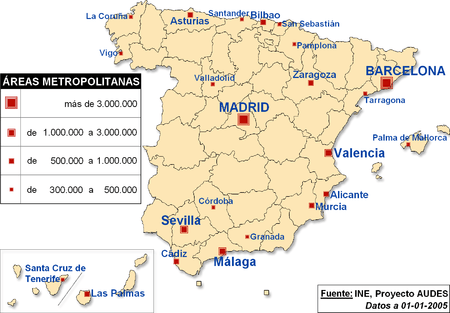
- Madrid 6,489,162
- Barcelona 5,375,774
- Valencia 1,705,742
- Seville 1,519,639
- Bilbao 950,155
- Málaga 897,563
- Asturias (Gijón–Oviedo–Avilés) 857,079
- Alicante–Elche 748,565
- Zaragoza 731,803
- Vigo - Pontevedra 662,412
- Las Palmas 616,903
- Bahía de Cádiz (Cádiz–Jerez de la Frontera) 615,494
- Santa Cruz de Tenerife 573,825
- Murcia 563,272
- Palma 474,035
- Granada 472,638
- San Sebastián 402,168
- Tarragona 406,042
- A Coruña 403,007
- Valladolid 400,400
- Santander–Torrelavega 391,480
- Córdoba 323,600
- Pamplona 309,631
Islands
Islander population:[25]
|
Ethnic groups
Definition of ethnicity or nationality in Spain is fraught politically. The term "Spanish people" (pueblo español) is defined in the 1978 constitution as the political sovereign, i.e. the citizens of the Kingdom of Spain. The same constitution in its preamble speaks of "peoples and nationalities of Spain" (pueblos y nacionalidades de España) and their respective cultures, traditions, languages and institutions. The formerly nomadic Gitanos and Mercheros are distinctly marked by endogamy and discrimination but they are dispersed through the country.
The native Canarians are the descendants of the population of the Canary Islands prior to Spanish colonization in the 15th century. Also included are many Spaniard citizens who are descendents of people from Spain's former colonies, mostly from Equatorial Guinea, Argentina, Dominican Republic, Ecuador, Peru, Colombia, Morocco and the Philippines. There is also a sizable number of Spaniards of Eastern European, Maghrebian, Sub Saharan-African, South Asian and Middle Eastern descent.[26]
Native-born Spanish citizens of all ethnic groups make up 88% of the total population, and 12% are immigrants. Among the immigrants, around 57% of them come from Spain's former colonies in Latin America (including those from Cuba, Argentina, Ecuador, Puerto Rico, Chile and Uruguay), former Spanish Africa and Philippines ( Southeast Asia ). The rest are mostly Eastern European (especially Romanians, Bulgarians, Russians, Serbians, Croatians, Bosnians, Ukrainians and Albanians), North and West Africans (notably Moroccans, Algerians, Senegalese, Guineans, Nigerians and Cameroonians), Middle Eastern peoples including the Lebanese and Syrian communities, South Asians including Indians and Pakistanis, and Chinese, as well as a sizable number of citizens from the European Union, as of 2007 mostly Romanians, Bulgarians, British, Portuguese, Polish (central Europe), and Germans.
List of largest minority groups in Spain by country as of 2011
| Rank | Nationality | Population (2011) |
|---|---|---|
| 1 | 798,104 | |
| 2 | 773,966 | |
| 3 | 316,756 | |
| 4 | 312,098 | |
| 5 | 250,087 | |
| 6 | 183,626 | |
| 7 | 177,520 | |
| 8 | 171,127 | |
| 9 | 153,245 | |
| 10 | 150,878 | |
Religions
As of 2018, 68.5% of the population define themselves as Catholic, 26.4% as non-believers or atheists, and 2.6% other religions according to the official Spanish Center for Sociological Research. [3] Among believers, 59% assert they almost never go to any religious service, by contrast, 16.3% attend one or more religious service almost every week. [3][5] Most Spaniards, especially younger ones, ignore Catholic doctrines on matters such as pre-marital sex, homosexuality and contraception.[6][7]
Languages
- Spanish 99% (88% mother tongue[27]) (official nationwide)
- Catalan 16%[28] (9% mother tongue[27]) (co-official in Catalonia, Balearic Islands, and Valencia — see Valencian)
- Galician 7% (5% mother tongue[27]) (co-official in Galicia)
- Basque 1.6% (1% mother tongue[27]) (co-official in Basque Country and designated areas in Navarre).
- Aranese (a variant of Gascon Occitan) is co-official in Val d'Aran, a small valley in the Pyrenees.
Others with no official status:
- Asturian-Leonese (in the former Kingdom of León and Asturias)
- Aragonese (in the province of Huesca, Aragon)
- Arabic (in the autonomous city of Ceuta)
- Berber (in the autonomous city of Melilla)
Literacy
definition: age 15 and over can read and write. Total population: 97.7%
Educational system
About 70% of Spain's student population attends public schools or universities. The remainder attend private schools or universities, many of which are operated by the Catholic Church.
Compulsory education begins with primary school or general basic education for ages 6–16. It is free in public schools and in many private schools, most of which receive government subsidies. Following graduation, students attend either a secondary school offering a general high school diploma or a school of professional study in all fields — law, sciences, humanities, and medicine — and the superior technical schools offer programs in engineering and architecture.
Notes
- ↑ In fertility rates, 2.1 and above is a stable population and have been marked blue, 2 and below leads an aging population and the result is that the population reduces.
See also
| Wikimedia Commons has media related to Demographics of Spain. |
References
- ↑ "Cifras de Población a 1 de enero de 2014" (PDF) (in Spanish). 30 June 2014. Retrieved 6 March 2015.
- ↑ "Spain's population falls for first time since 1940s as immigrants flee crisis". Toronto. 22 April 2013. Archived from the original on 13 May 2013.
- 1 2 3 4 Centro de Investigaciones Sociológicas (Centre for Sociological Research) (January 2018). "Barómetro de enero de 2018" (PDF) (in Spanish). p. 19. Retrieved 3 March 2018.
- ↑ "Eurobarometer on Social Values, Science and technology 2005 - page 9" (PDF). Retrieved 2007-05-05.
- 1 2 "Eurobarometer 69 - Values of Europeans - page 16" (PDF). Retrieved 2009-03-24.
- 1 2 Tarvainen, Sinikka (26 September 2004). "Reforms anger Spanish church". Dawn International. Retrieved 2008-03-21.
- 1 2 "Zapatero accused of rejecting religion". Worldwide Religious News. 15 October 2004. Archived from the original on 23 October 2008. Retrieved 2008-03-21.
- ↑ Official report on Spanish recent Macroeconomics, including data and comments on immigration Archived 26 July 2008 at the Wayback Machine.
- ↑ Source: Instituto Nacional de Estadística. Evolution of the foreign population in Spain since 1998 "Archived copy". Archived from the original on 29 September 2007. Retrieved 2007-09-29.
- ↑ Source: Instituto Nacional de Estadística, Evolution of the global fertility rate between 1975 and 2005
- ↑ ABC. "El 75% de los nuevos habitantes de España es extranjero, según un estudio - Nacional_Sociedad - Nacional - ABC.es". ABC.
- 1 2 La evolución de las familias numerosas (Spanish)
- ↑ Fernández, Celia Valiente. "Forgetting the past: The familiar policy of Spain (1975-1996)" (PDF). Charles III University of Madrid.
- ↑ The first 'patera' arrived to Canary Islands 20 years ago - Público newspaper (Spanish)
- ↑ "Saldo migratorio en España desde 1940 / Net migration in Spain since 1940". 7 July 2014.
- 1 2 3 4 "Life expectancy". Our World in Data. Retrieved 2018-08-28.
- ↑ "World Population Prospects – Population Division – United Nations". Retrieved 2017-07-15.
- 1 2 3 4 5 6 7 8 Max Roser (2014), "Total Fertility Rate around the world over the last centuries", Our World In Data, Gapminder Foundation
- ↑ "Fondo documental. Historia". www.ine.es.
- ↑ "Instituto Nacional de Estadística Vital Statistics".
- ↑ "Movimiento Natural de la Población(Nacimientos, Defunciones y Matrimonios). Indicadores Demográficos Básicos" (PDF). Instituto Nacional de Estadística. INE. Retrieved 12 December 2017.
- ↑ World Population Review: Spain Population 2018, 14 June 2018
- ↑ "World Factbook EUROPE : SPAIN", The World Factbook, July 12, 2018
- ↑ "AUDES project". Grupo Alarcos. Archived from the original on 22 August 2011. Retrieved 2008-08-14.
- ↑ La superficie de las islas vendrá dada en hectáreas salvo la de las mayores islas de los archipiélagos canario y balear, así como las Plazas de Soberanía.
- ↑ "Ethnic Groups in Spain | Study.com". Study.com. Retrieved 2018-05-09.
- 1 2 3 4 "Europeans and their languages" (PDF). ec.europa.eu. European Commission. February 2006.
- ↑ "Spain".
External links
- Spanish Instituto Nacional de Estadística Statistical data about demography and population
- Build Spanish population graph 1960 - 2013 (World Bank data)
- Build Spanish population projection graph till 2100 (United Nation data)
- Build Spanish life expectancy at birth graph 1950 - 2013 (United Nation data)